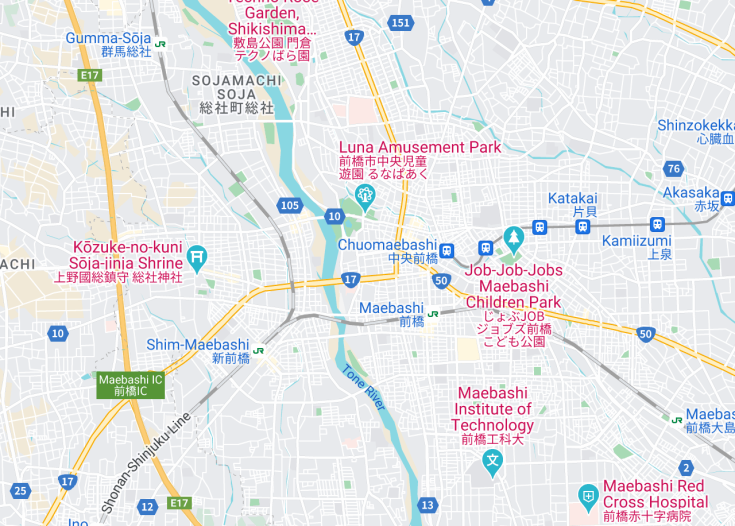Maebashi, the capital city of Gunma Prefecture in Japan, is a haven of natural beauty and cultural richness. Known as the “City of Water, Greenery, and Poets,” Maebashi is situated at the foot of Mt. Akagi and is blessed with abundant clear water sources and lush green landscapes. This city not only offers scenic beauty but also serves as a hub for literary history, having been home to several prominent Japanese poets. Visitors can explore historical sites, enjoy local cuisine, and participate in vibrant festivals that celebrate the seasons and local culture.
For a unique experience, explore the Maebashi Flower Park. This vast area is especially breathtaking during the cherry blossom season, creating perfect photo opportunities.
Don’t miss out on a visit to the Gunma Prefectural Museum of History to deepen your understanding of the region’s rich heritage and the legacy of its literary figures.
Top things to do & see in Maebashi
Select the following sights and activities to discover best tickets and tours available in Maebashi.
Maebashi: Japan’s Flourishing Heartland
| Country | Japan |
| Time in Maebashi | GMT+9 |
| Language spoken | Japanese |
| Population | 339,583 (Source: Japan National Statistical Bureau, 2023) |
| Currency | Japanese Yen (¥, JPY) |
| Airports |
|
Maebashi, the capital city of Gunma Prefecture in Japan, is renowned for its historical significance and cultural heritage. Nestled at the foot of the Japanese Alps, Maebashi is often referred to as the “City of Water, Greenery, and Poets” due to its beautiful natural landscapes and its affiliation with many famous literary figures. The city thrives on a balanced blend of tradition and modernity, hosting vibrant festivals that showcase its rich culture and history.
Where is Maebashi?
Located in central Japan, north of Tokyo, Maebashi lies along the Tone River, making it a picturesque city amidst the highlands.
Distances:
| Route | Distance by car | Time by car |
|---|---|---|
| Tokyo to Maebashi | 107 km | Approx. 2 hours |
| Yokohama to Maebashi | 151 km | Approx. 2 hours 40 min |
| Nagoya to Maebashi | 288 km | Approx. 4 hours 20 min |
What is Maebashi famous for?
Maebashi is famous for its rich cultural history, scenic beauty, and agricultural produce, particularly its silk and daruma dolls. It’s also well-known for its hot springs and outdoor recreational activities.
History
Pre-Modern Period (Before 1600)
The area known today as Maebashi, located in the Gunma Prefecture of Japan, has been inhabited since ancient times. Archaeological findings such as Jomon period potteries suggest that the first human settlements could date back to around 14,000 BC. During the Yayoi Period, starting around 300 BC, the region witnessed the arrival of rice cultivation techniques and the establishment of permanent farming settlements.
Edo Period (1603-1868)
The Edo period marked significant developments for Maebashi. The establishment of Maebashi Han, a feudal domain under the Tokugawa shogunate, helped the town prosper as a political and economic center. Maebashi Castle was constructed in the early 17th century, signifying the town’s growing importance. By the mid-19th century, Maebashi had developed into a thriving market town, facilitating trade in silk and other goods among the nearby regions.
Modernization and Growth (1868-1945)
With the Meiji Restoration in 1868, Maebashi embraced modernization. The introduction of rail transportation and modern educational institutions further enhanced its status. In 1892, it officially became recognized as a city. The 20th century brought industrial expansion, especially in silk and textile production, which boosted the local economy significantly until the Second World War.
Post-War Period and Contemporary Era (1945-Present)
Post-World War II recovery was quick for Maebashi, aided by the resurgence of industries and the expansion of educational facilities. The city became a prefectural capital in 1949, consolidating its administrative significance. Today, Maebashi is known for its cultural attractions, parks, and as a hub for outdoor activities, reflecting its historical legacy while continually evolving into a modern urban center.
Visit Maebashi
What to see and do in Maebashi, Japan
Maebashi offers a captivating mix of historical sites, natural beauty, and modern attractions. Key places to visit include:
- Maebashi Castle, offering insights into the city’s feudal past
- Akagi Shrine, a serene spiritual site nested in lush greenery
- Gunma Flower Park, featuring vibrant floral displays year-round
- The Maebashi City Museum of Literature, dedicated to local literary history
- Akagi Nature Park for hiking and outdoor activities
Visitors can also enjoy cycling along the Tone River or explore the many local shops and cafés in the city center.
Annual Events in Maebashi
Maebashi is vibrant with various festivals and events throughout the year:
- The Maebashi Fireworks Festival in August, which lights up the summer sky
- The Daruma Doll Fair in January, where visitors can purchase traditional lucky dolls
- The Green Dome Maebashi Concerts, hosting performances from both local and international artists
These events offer a great way to experience the local culture and traditions.
Best time to visit Maebashi
The best times to visit Maebashi are spring, from March to May, when the cherry blossoms are in bloom, and autumn, from September to November, when the autumn colors are spectacular. These periods offer mild weather ideal for exploring the outdoors and engaging in cultural events.
Is Maebashi worth visiting?
Maebashi offers a balanced blend of historical depth, cultural richness, and beautiful natural scenery, making it a worthwhile destination, especially for those interested in Japan’s history and nature. The city caters well to both adventure seekers and those looking to explore traditional Japanese culture through its various festivals and historical sites. However, it might not cater as strongly to those seeking a vibrant nightlife or extensive luxury shopping experiences. Travelers should also be prepared for rural driving conditions when exploring more remote attractions.










